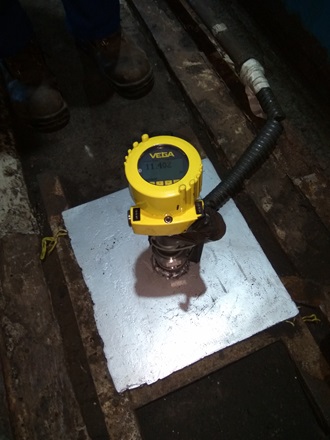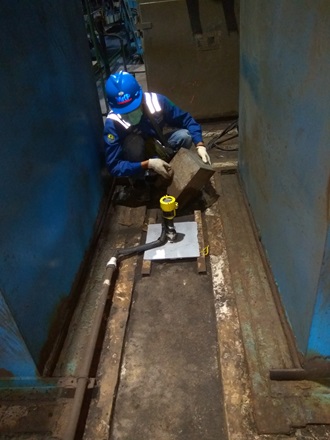VEGAPULS 69 level sensor secures coal supply in an Indonesian power plant
The demand for electricity is growing rapidly in Indonesia. Consumption increases by around 10 percent every year. To meet the growing demand, the Indonesian government is aggressively expanding power capacities. In its first phase, the Indonesian government's "Fast Track Program" (FTP) will provide around 10,000 MW.
Indonesian authorities commissioned the power company PT PLN in 2009 to build 37 new coal-fired power plants at various locations throughout Indonesia. One of these is the Tanjung Awar-Awar power plant. This two-block, 700 MW coal-fired power plant in East Java was completed in 2012/13 and is managed by PT Pembangkit Jawa Bali (PJB), a subsidiary of PT Perusahaan Listrik Negara (PLN), The company acts as asset manager as well as operator, and this is where VEGA proved to be a valuable partner for pressure and level measurement technology.
Reliable level sensors ensure combustion chambers charge interruption-free
Without a reliable supply of coal, even the best power plant couldn’t deliver the required energy, so reliably monitoring the coal reserves becomes absolutely essential.
The coal is delivered by sea and unloaded into bunkers up to nearly 100 feet high. Coal is transported to these bunkers from the stockpiles of the power plant via conveyor belt systems above or below ground. From there, the coal has to be transported to the mills where it is ground into a fine powder for subsequent combustion in the combustion chamber of the furnace.
Reliable level sensors are required at every step of the way to prevent overfilling in the bunkers and ensure uninterrupted charging in the combustion chamber. Continuous monitoring of the minimum level in the coal dust silos is especially critical, because a supply interruption to the furnaces must be avoided at all costs.
Unfortunately, the prevailing ambient conditions in coal bunkers are not the easiest – any sensor quickly gets covered with dust and dirt. At the power plant in Tanjung, the company regularly struggled with a measuring point that was supposed to display the precise height and resultant quantity of the coal reserves. Unfortunately, the reading constantly jumped to the 100 percent value despite the actual level sitting close to zero. The dusty environment, the loud filling noises, and the typical bulk material distribution in the bunkers all caused problems for the measuring instrument.
Level sensors persist with high temperature and chemical resistance
The power company had a number of good experiences with VEGA products at other measuring points in the plant. The power plant uses a VEGAWAVE 62 in the fly ash silo, a VEGAPULS WL S 61 for a wastewater measurement, and a VEGAPULS 64 for measuring the level in the chlorine tank just to name a few examples.
When it came to this difficult measurement, they asked the radar experts in Schiltach for some advice. They recommended VEGAPULS 69, which offers great reliability, especially in dusty, dirty environments due to its 80 GHz high measuring frequency. The sensor was first demonstrated in a small seminar room with the help of a canopy as the level and books as objects causing interfering signals. The presentation was convincing enough, despite the improvised setup. The company decided to give the VEGAPULS 69 a chance.
Ever since its market launch, the VEGAPULS 69 has been regarded as a robust problem-solver. With a measuring range of up to 120 m and an accuracy of ±5 mm, the sensor was more than enough, even in the most challenging applications. The bunker height of nine meters was no problem for the VEGAPULS 69.
The sensor's antenna system is made of the robust material, PEEK, which has a high temperature and chemical resistance. Its lens antenna is also immune to build-up and dirt and shows no signs of wear. Another great advantage in this application is the 80-GHz microwaves easily penetrate the dense clouds of coal dust. The sensor has a flushing air connection as a standard feature, so it can clean itself quickly at any time and "dispose" of any build-up.
Even in this difficult application, the VEGAPULS 69 is completely unaffected by the deposits of fine coal dust on the antenna, and it has been delivering accurate measured values continuously since its installation. The coal supply is no longer at risk.
We need your consent
This content is provided by an external provider. If you activate the content, personal data may be processed and cookies set.
Wireless communication via Bluetooth for hard-to-reach places
The operator appreciates this practical solution not only because of its sophisticated technology. PT PLN also values the fast and unbureaucratic support that VEGA has provided during the nearly ten years of collaboration, whether it was in the form of technical advice, spare parts or special help with problematic measurements.
Related industries

Coal power plant
Products
Export this article
Download as PDFShare this article
Comments ({{comments.length}})
{{getCommentAuthor(comment, "Anonymous")}} {{comment.timestamp | date : "dd.MM.yyyy HH:mm" }}
{{comment.comment}}







